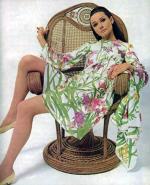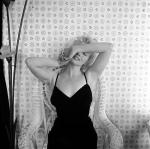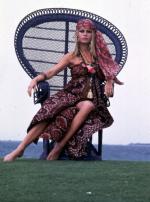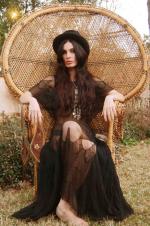Poses photographiques - Focus sur l'accessoire de la chaise en osier
Séance du siège en osier
Sitting of the Wicker Chair
La séance "en osier" de Marilyn Monroe photographiée par Milton Greene à New York en septembre 1954 la représente assise sur un siège en osier.
The "Wicker" sitting of Marilyn Monroe photographed by Milton Greene in New York in September 1954 depicts her sitting on a wicker chair, called peacock chair.
Milton Greene la photographie le 10 septembre 1954 pour la désormais célèbre séance en tutu de ballerine, où Marilyn prend appui, puis s'asseoit sur un siège en osier.
Milton Greene photographs her on September 10, 1954 for the now famous ballerina session, where Marilyn leans and sits down on a wicker seat.
Marilyn reprendra la pose dans un siège en osier blanc, sous l'objectif de Cecil Beaton et de son assistant Hans Knopf le 22 février 1956 à l'hôtel Ambassador de New York.
Marilyn will strike a similar pose in a white wicker chair, photographed by Cecil Beaton and his assistant Hans Knopf on February 22, 1956 at the Ambassador Hotel in New York.
Il s'agit de fauteuils d'origine Tahitienne, appelés fauteuils Pomare. Avec son allure de "trône", qu'il tient de ses origines car était l'assise des rois de Tahiti (la dynastie des Pomare, d'où il tient son nom), il fait son apparition à la fin du XIXème siècle, quand le prince Hinoï, neveu de Pomare V (le dernier roi de la dynastie des Pomare), meurt dans l'un de ces fauteuils.
Mi-élégant, mi-décontracté, son dossier est plus ou moins haut et évasé, l'osier est travaillé et ajouré par des lignes entrelacées formant des jeux géométriques, figuratifs ou non.
These are chairs of Tahitian origin, called Pomare armchairs. With its appearance of "throne", which it holds from its origins because it was the seat of the kings of Tahiti (the Pomare dynasty, from which it takes its name), he made its appearance at the end of the XIX century, when Prince Hinoï, nephew of Pomare V (the last king of the Pomare dynasty), dies in one of these armchairs.
Mid-elegant, half-relaxed, with its backrest is more or less high and flared, the wicker is worked and perforated by intertwined lines forming geometric shapes, figuratives or not.
Hollywood et le cinéma européen, autant que les photographes, vont se l'approprier; déjà au début du XXème siècle (dès les années 1920s), des femmes sont photographiées assises dans un grand siège en osier.
Hollywood and european cinema, as much as photographers, will appropriate it; already in the early twentieth century (years 1920s), women are photographed sitting in a big wicker seat.
Peu d'hommes sont photographiés assis dans une chaise en osier; ce petit fauteuil reste principalement "féminin" dans l'iconographie.
Few men are photographed sitting in a wicker chair; this little chair remains mainly "feminine" in the iconography.
L'assise du fauteuil en rotin va devenir un accessoire très utilisé dans la photographie mettant en scène les plus belles femmes du monde entier: actrices, chanteuses et mannequins.
The seat of the rattan chair will become a widely used accessory in the photography featuring the most beautiful women in the world: actresses, singers and models.
- Carolyn Jones, "The Addams Family", 1965s - 
- Jean Shrimpton & Cecil Beaton, 1965 -
- Audrey Hepburn, septembre 1966, William Klein - 





- Marianne Faithfull, fin 1960s -
L'actrice Sylvia Kristel va érotiser le fauteuil en rotin: elle y est représentée dénudée sur l'affiche du film érotique français Emmanuelle en 1974 (film qui va connaître un succès mondial). A partir de cette photographie iconique qui va devenir culte, le fauteuil en rotin devient alors indissociable de la féminité et la sensualité et l'incarnation des moeurs libérées et de la vie de bohème des années 1970s; et il est désormais nommé et connu sous le nom du "fauteuil d'Emmanuelle" !
The actress Sylvia Kristel will eroticize the rattan armchair: she is represented naked on the poster of the French erotic film Emmanuelle in 1974 (a film that will be a worldwide success). From this iconic photograph that will become cult, the rattan armchair becomes inseparable from femininity and sensuality and incarnation of liberated mores and bohemian life of the 1970s; and it's now named and known as the "Emmanuelle's chair" !
- Sylvia Kristel, "Emmanuelle", 1974 -

- Juliet Prowse, danseuse et actrice, 1970s -
- Al Green, 1972, illustration de son album -
- Romy Schneider en famille 1979 - 
- Marc Bolan, 1983, illustration de son album -
Dans les années 2000s et 2010s, des mannequins sont représentées assises dans un siège en rotin pour souvent illustrer une mode à tendance hippie ou folk. Le fauteuil reste indémodable dans les intérieurs à tendance déco, qu'il soit placé dans une chambre ou dans un salon, ou à l'extérieur sur une terrasse ou dans une véranda, et comporte des connotations bohèmiennes d'authenticité, par son aspect vintage et de sensualité par l'imagerie d'Emmanuelle.
In the years 2000s and 2010s, models are represented sitting in a rattan seat to often illustrate a trend with hippie or folk tendency. The armchair is timeless in deco-style interiors, whether in a bedroom or in a living room, or outside on a terrace or veranda, and has Bohemian connotations of authenticity, with its vintage look and sensuality through Emmanuelle's imagery.
All photos are copyright and protected by their respective owners.
copyright text by GinieLand.

/image%2F1211268%2F20240315%2Fob_782fd3_banner-mm-2024-03-spring-5.jpg)
/image%2F1211268%2F20240410%2Fob_40c4f9_blog-gif-mm-niagara-1-3.gif)

/image%2F1211268%2F20240417%2Fob_0b0d56_2024-03-lee-mexique.jpg)
/https%3A%2F%2Fstorage.canalblog.com%2F19%2F65%2F312561%2F91436129_o.jpg)
/https%3A%2F%2Fstorage.canalblog.com%2F57%2F63%2F312561%2F127743382_o.jpg)
/https%3A%2F%2Fstorage.canalblog.com%2F98%2F05%2F312561%2F84823731_o.jpg)
/https%3A%2F%2Fstorage.canalblog.com%2F01%2F63%2F312561%2F84814201_o.jpg)
/https%3A%2F%2Fstorage.canalblog.com%2F66%2F21%2F312561%2F82823948_o.jpg)
/https%3A%2F%2Fstorage.canalblog.com%2F32%2F31%2F312561%2F124125043_o.jpg)
/https%3A%2F%2Fstorage.canalblog.com%2F31%2F08%2F312561%2F71448014_o.jpg)
/https%3A%2F%2Fstorage.canalblog.com%2F34%2F90%2F312561%2F81829009_o.jpg)
/https%3A%2F%2Fstorage.canalblog.com%2F18%2F35%2F312561%2F61120383_o.jpg)
/image%2F1211268%2F20240410%2Fob_9f471d_blog-gif-mm-syi-1.gif)




















































































/image%2F1211268%2F20240324%2Fob_e56f1f_wp-mhgred-peakpx.jpg)
/http%3A%2F%2Fstorage.canalblog.com%2F07%2F62%2F312561%2F134213691_o.jpeg)
/http%3A%2F%2Fstorage.canalblog.com%2F73%2F41%2F312561%2F133928131_o.jpg)

/image%2F1211268%2F20240229%2Fob_66f2c6_tag-mm-public-martin-lewis-show-1.png)
/image%2F1211268%2F20240410%2Fob_07cb4a_blog-gif-mm-stern-1.gif)
/image%2F1211268%2F20240229%2Fob_143453_blog-gif-video.gif)
/image%2F1211268%2F20240301%2Fob_735dec_blog-liens-culture.jpg)

/image%2F1211268%2F20240302%2Fob_e11252_blog-liens-friends-jane.gif)